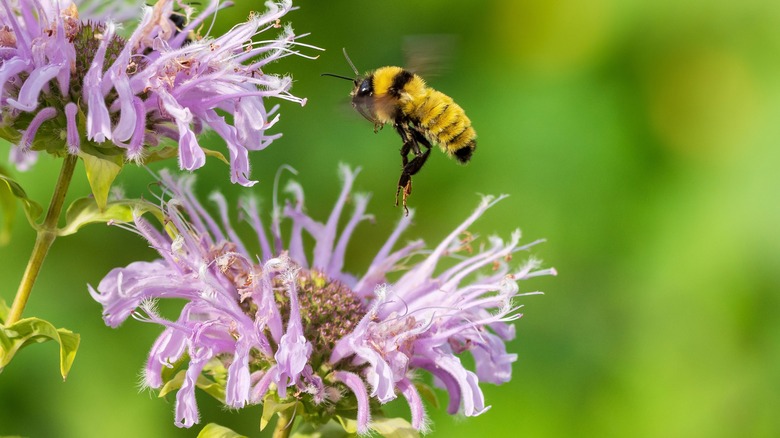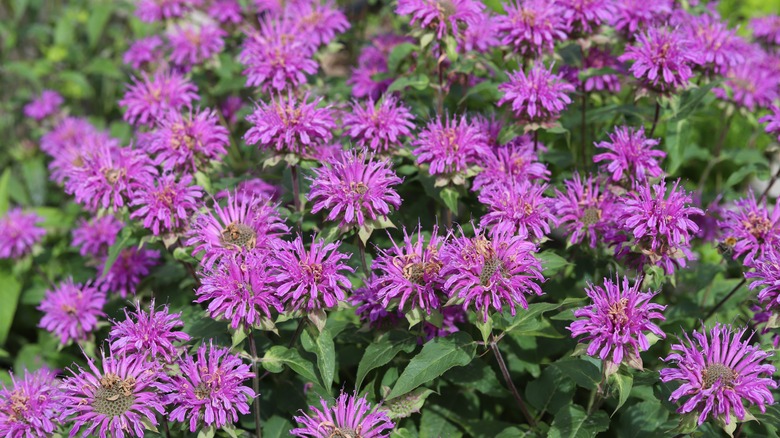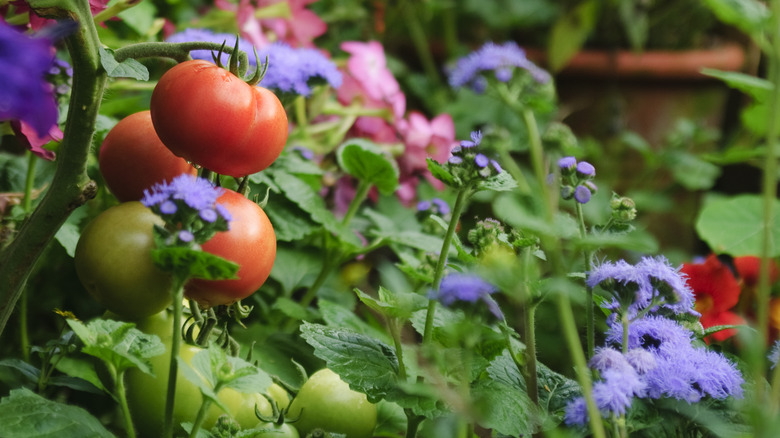Plants You Shouldn't Grow Next To Bee Balm
If you're looking for colorful flowers that will bring bees into your yard, you may have heard about the many benefits of including bee balm in the garden. Also known as bergamot, bee balm (Monarda spp.) is a bee (and hummingbird!) magnet, thanks to its aromatic petals and nectar-rich center. Not only does it benefit pollinators, but it blooms in stunning shades of pink, white, purple, and red. It's also relatively easy to grow for gardeners in USDA hardiness zones 3 through 9 and requires little more than full to partial sun and nutrient-dense moist soil to thrive. But in order to make your bee balm as healthful to pollinators as it is beautiful, there are some plants (such as those from the mint family) you should avoid planting next to it.
Plants may be incompatible with bee balm for a variety of reasons. They may be aggressive spreaders, resource-competitive, require different growing conditions, or become so tall and wide that they block the bee balm from receiving plenty of sunlight. Any of these factors can harm your bee balm plants, which is sad for your garden and any pollinators in the area. That's why it's key to know which plants to avoid planting alongside your bee balm, as well as what plants may benefit the bee balm and other pollinators, in order to make your bee balm as effective as possible.
Aggressive, resource-hungry plants harm bee balm
Mint is known for easily growing in just about any soil or sun conditions. As a part of the mint family, bee balm can quickly overrun the garden, as it is an aggressive spreader itself. This means that bee balm will gobble up resources and reach its roots as far as possible, and its siblings peppermint (Mentha piperita L.) and spearmint (Mentha spicata) will want to do the same. If too many aggressively spreading plants require more nutrients than one area of a garden can provide in its soil, the plants may all become stunted or choke one another out. Aggressive spreading is not limited to the mint family, but which species are considered aggressive or invasive varies from region to region, so be sure to do some research before planting any other plants near your bee balm.
You also want to be cautious about planting heavy feeder plants alongside bee balm. Heavy feeders are plants that require significant amounts of key soil nutrients such as nitrogen, phosphorus, and potassium. To maintain themselves, these types of plants will slurp up all nutrients from the soil, which can stunt other plants such as bee balm. Unfortunately, many vegetable plants are considered heavy feeders. Tomatoes, corn, squash, and other summer heat-loving vegetables all fall in this category and, for that reason, shouldn't be planted next to bee balm.
Companion planting for bee balm
Your bee balm may benefit from companion planting, a centuries-old agricultural practice in which plants are grown near each other for a symbiotic relationship, whether they increase the health and growth of one another or, in the case of bee balm, make one crop more appealing to pollinators than it would be on its own. However, bee balm does have some excellent companion plants that can live happily alongside it and help attract other pollinators into your garden. Black-eyed Susans (Rudbeckia hirta) are also beloved by pollinators, and while they can become aggressive if planted on their own, can be contained when planted alongside a competitive plant. Similarly, golden groundsel (Packera aurea) is pollinator-friendly and also benefits from a little competition from other fast-growing plants, as it will stomp out less aggressive plants.
You can also get creative with placement and container gardening with pots and planters. Planter boxes are an excellent way to ensure each plant is in an area where it can receive necessary space, nutrients, soil, and other growing conditions. Consider having a designated pollinator garden in one box and a thriving veggie crop in another so that the vegetable crops can benefit from the nearby pollination. Additionally, you can look for light-feeding veggies to plant alongside bee balm, as these won't present the same challenges as heavy-feeders. Light-feeder vegetables include peas, turnips, Jerusalem artichokes, chickpeas, lamb's lettuce, and beans.


